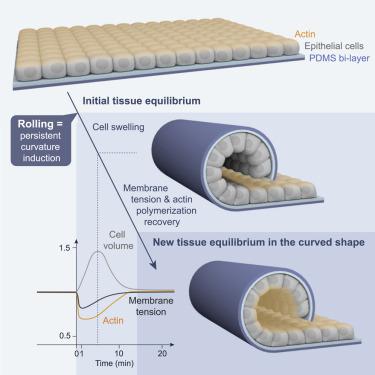Developmental Cell ( IF 11.8 ) Pub Date : 2022-05-13 , DOI: 10.1016/j.devcel.2022.04.017 Caterina Tomba 1 , Valeriy Luchnikov 2 , Luca Barberi 1 , Carles Blanch-Mercader 1 , Aurélien Roux 3

|
Generation of tissue curvature is essential to morphogenesis. However, how cells adapt to changing curvature is still unknown because tools to dynamically control curvature in vitro are lacking. Here, we developed self-rolling substrates to study how flat epithelial cell monolayers adapt to a rapid anisotropic change of curvature. We show that the primary response is an active and transient osmotic swelling of cells. This cell volume increase is not observed on inducible wrinkled substrates, where concave and convex regions alternate each other over short distances; and this finding identifies swelling as a collective response to changes of curvature with a persistent sign over large distances. It is triggered by a drop in membrane tension and actin depolymerization, which is perceived by cells as a hypertonic shock. Osmotic swelling restores tension while actin reorganizes, probably to comply with curvature. Thus, epithelia are unique materials that transiently and actively swell while adapting to large curvature induction.
中文翻译:

上皮细胞通过瞬时主动渗透肿胀适应曲率诱导
组织曲率的产生对于形态发生至关重要。然而,细胞如何适应变化的曲率仍然是未知的,因为有工具可以在体外动态控制曲率缺乏。在这里,我们开发了自滚动基板来研究扁平上皮细胞单层如何适应曲率的快速各向异性变化。我们表明,主要反应是细胞的活跃和短暂的渗透肿胀。这种细胞体积增加在可诱导起皱的基材上没有观察到,其中凹凸区域在短距离内相互交替;这一发现将肿胀确定为对曲率变化的集体反应,并在大距离内具有持续的迹象。它由膜张力下降和肌动蛋白解聚触发,细胞将其视为高渗性休克。渗透性肿胀恢复张力,而肌动蛋白重组,可能是为了顺应曲率。因此,上皮细胞是一种独特的材料,可在适应大曲率感应的同时短暂且主动地膨胀。


























 京公网安备 11010802027423号
京公网安备 11010802027423号